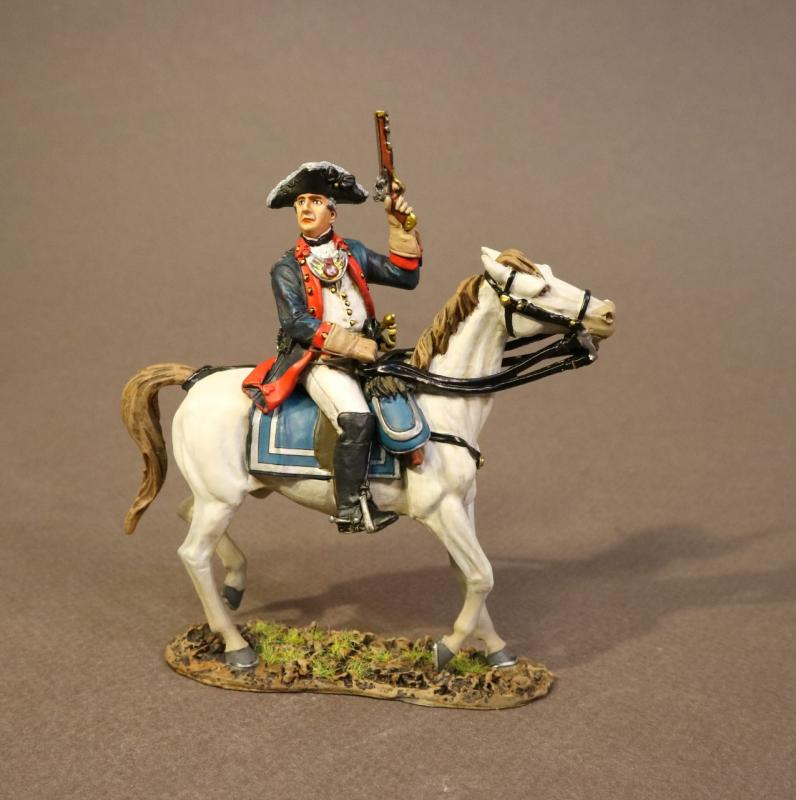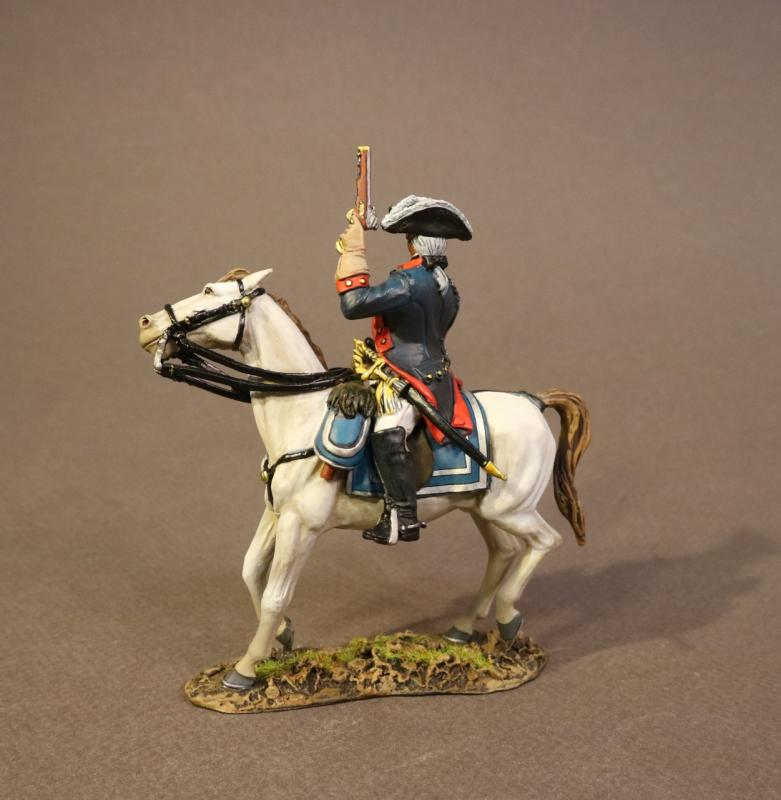Lt. Col. Heinrich Von Breymann, The Battle of Saratoga, 1777, Drums Along the Mohawk--single mounted figure--RETIRED--LAST ONE!!
$98.00
Item Number: SGEN-04
Lt. Col. Heinrich Von Breymann, The Battle of Saratoga, 1777, Drums Along the Mohawk
Heinrich von Breymann (died 1777) was a German Brunswick-Wolfenbüttel lieutenant colonel who fought as an officer in the service of Great Britain during the American Revolutionary War. He was commander of the Breymann Grenadiers, a Brunswick battalion hired into British service, and served under the command of John Burgoyne. During the Battles of Saratoga, Breymann's unit was driven behind a redoubt, where he grew frustrated at the poor performance of his men, allegedly attacking four with his saber. It is possible that he was killed by “friendly fire”.
Assault on the Breymann Redoubt, 7th October 1777
“The surrender that changed the world”.
In October 1777, a 6,000 strong British army surrendered in defeat after the American victory at the Battles of Saratoga.
For the first time in history a British General surrendered his sword
The German mercenaries were firing steadily from their redoubt.
From the rear came the crack of rifles. A general mounted and, his sword flashing, led the riflemen into the redoubt. German resistance collapsed. The Battle of Saratoga was over.
The day was Oct. 7th, 1777. Twelve days later, “Gentleman Johnny” Burgoyne, the gifted, courageous British commander, surrendered to the American general, Horatio Gates. Thus ended the most ambitious and dangerous offensive launched by Britain in the Revolution. The attack on the redoubt was the last of a series of actions that constituted the Battle of Saratoga, considered the turning point of the Revolution.
The rifle fire that decimated the Germans awoke echoes around the World. The French court, friendly to any who fought their ancient British enemy, finally was convinced that France’s interest lay in entering the war on the side of the Americans.
Following intense fighting with the Continental Army in September, the British Army fortified themselves behind two defensive redoubts--the larger, better defended Balcarres Redoubt, and the weaker Breymann Redoubt.
American forces, led by General Benedict Arnold, managed to take the Breymann Redoubt, which gave them a strong position behind the British lines. The loss of the Redoubt rendered the British position untenable. The British Army was forced to pull back to the river, from which position they would attempt to retreat north the next morning.
THE CONTINENTAL ARMY
The Continental Army was formed by the Second Continental Congress after the outbreak of the American Revolutionary War by the colonies that became the United States of America. Established by a resolution of the Congress on June 14, 1775, it was created to coordinate the military efforts of the Thirteen Colonies in their revolt against the rule of Great Britain. The Continental Army was supplemented by local militias and troops that remained under control of the individual states or were otherwise independent. General George Washington was the commander-in-chief of the army throughout the war.
The Continental Army consisted of soldiers from all 13 colonies and, after 1776, from all 13 states. When the American Revolutionary War began at the Battles of Lexington and Concord on April 19, 1775, the colonial revolutionaries did not have an army. Previously, each colony had relied upon the militia, made up of part-time citizen-soldiers, for local defense, or the raising of temporary "provincial regiments" during specific crises such as the French and Indian War of 1754–63. As tensions with Great Britain increased in the years leading to the war, colonists began to reform their militias in preparation for the perceived potential conflict. Training of militiamen increased after the passage of the Intolerable Acts in 1774. Colonists such as Richard Henry Lee proposed forming a national militia force, but the First Continental Congress rejected the idea.
The Continental Army of 1777–80 evolved out of several critical reforms and political decisions that came about when it became apparent that the British were sending massive forces to put an end to the American Revolution. The Continental Congress passed the "Eighty-eight Battalion Resolve", ordering each state to contribute one-battalion regiments in proportion to their population, and Washington subsequently received authority to raise an additional 16 battalions. Enlistment terms extended to three years or to "the length of the war" to avoid the year-end crises that depleted forces (including the notable near-collapse of the army at the end of 1776, which could have ended the war in a Continental, or American, loss by forfeit).
Three of the Continental Army units which took part in the assault on the Breymann Redoubt, were the 2nd Massachussetts, the 2nd New York, and the 1st Canadian Regiment.
Ebenezer Learned (April 18, 1728 – April 1, 1801) was a brigadier general in the American Continental Army during the Revolutionary War.
He was the son of Ebenezer and Deborah Haynes Learned, and was born at Oxford, Massachusetts, and lived his entire life in the area. On October 5, 1749, he married Jerusha Baker (1732–1789) and they had nine children. When his grandfather died in 1750, he inherited 200 acres (0.8 km²) known as Prospect Hill, and built his home there.
Learned was an active member of the local militia, and raised and drilled a company at Oxford during the French and Indian War. In the summer of 1756, he led his company to Fort Edward at Lake George. There is little record of his service, except that he served sporadically from then until 1763. He fell ill with smallpox in 1757 and was hospitalized for a month.
After that war, he remained at home for several years, farming and operating a tavern at Oxford. He was prominent in both church and community, and served as a town selectman for 25 of the years between 1758 and 1794.
He remained active in the militia, and led his own and a neighboring company of minutemen to Boston, where he received the news of the Battle of Lexington on April 19, 1775. On April 24, the Massachusetts committee of safety named him a colonel and authorized him to organize a regiment that was known as Learned's Regiment. His regiment was adopted into the Continental Army in June. In 1776, those who re-enlisted were augmented by men from Danielson's Regiment to form the 3rd Continental Regiment.
By the end of the Siege of Boston, General Washington had given Learned command of the important Dorchester Heights position. When the British evacuated Boston on March 17, 1776, Colonel Learned was the first to enter the city. He led a battalion of 500 specially selected men, to clean out the traps, abatis, caltrops, and garbage left by the British. He and the men were selected because they had all had survived smallpox or had been inoculated.
Learned resigned in May 1776, due to ill health, but returned to duty on April 2, 1777. He was named a brigadier general and assigned to the Northern Department. In the first phase of the Battle of Saratoga, the Battle of Freeman's Farm, his brigade was not very effective. Working forward in the center of the line, they mainly got lost in the woods, and exchanged light fire near the end of the battle.
At the Battle of Bemis Heights, his brigade was in the center of the left division, fighting alongside Daniel Morgan and Enoch Poor. They were commanded by General Benjamin Lincoln. Learned's own brigade (the 2nd, 8th, and 9th Massachusetts line), was expanded by James Livingston's 1st Canadian Regiment and 2 regiments of New Hampshire Militia the 2nd and 4th. The attack on the American far left was turned by Daniel Morgan's men, but the enemy's center was held by Hessian troops. Benedict Arnold came onto the field and encouraged the men. Arnold and Learned led a joint charge on the Hessian positions, and, even though Arnold fell wounded, Learned and his men carried through and broke the enemy lines. Burgoyne's forces had to retreat to their starting fortifications around Freeman's Farm. When their charge carried the first bunker, Burgoyne's forces withdrew to the positions they had held before the Freeman's Farm battle.
After Saratoga, his was the first unit to guard and escort the surrendered Convention Army on its trek to the south. In 1777–78, he commanded a brigade of Massachusetts troops in Major General deKalb's division at Valley Forge. On March 24, 1778, his continuing health problems led to his final resignation.
Released in JULY 2019.
RETIRED.
LAST ONE!!

